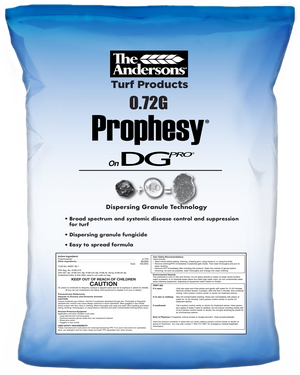
Preventative or curative, that is the question. On the one hand, disease doesn’t always occur, so we can wait and act curatively. On the other hand, disease prevention is often easier and more broad-spectrum, and there won’t be damaged turf to repair. These approaches also vary in time, labor, and material costs.
There is an adage among turf managers that says, “An ounce of fungicide product applied preventatively is equivalent to a pound of product applied curatively.”
Trying to apply fungicide after the onset of disease symptoms will stop the progression of the pathogen, but the turf that has already suffered damage will have to regrow. This can cause great frustration with homeowners and can lead to decreased revenue if the customer decides to leave the program.
Why does turf disease occur?
Diseases result from many causes, both biotic (a pathogen) and abiotic (a traffic-stressed or nutrient-deprived turf). Most often, pathogens are regarded as the causal agent of the disease. But a stressed, hungry lawn may be more susceptible to being a pathogen host. Remember the disease triangle?

Three things must occur simultaneously for turf disease to develop: a susceptible host, environmental conditions that favor the disease, and a pathogen present to infect the host.
Why does summer weather tend to bring disease?
Summer weather often means heavy disease pressure for many parts of the country. High heat and humidity offer optimum environmental conditions for increased pathogen populations while also weakening the turf plant through increased stress.

Summer irrigation can also favor disease incidence due to increased leaf wetness and canopy humidity. The stresses and weather of summer bring forth the importance of cultural and chemical disease control or prevention.
What can be done to avoid summer turf diseases?
Cultural disease prevention is rooted in avoiding a susceptible host. Properly fertilized, watered, and maintained (sharp cutting units, avoidance of excessive traffic, etc.) turfgrass is less likely to be a susceptible host. Overseeding with disease-tolerant cultivars or applying irrigation at the correct time of day are other cultural prevention techniques.
Chemical disease prevention centers around proper fungicide application to reduce pathogen populations, especially when environmental conditions are favorable for disease development. The timing of the application will determine whether you take a preventative or curative approach.

When is the right time to apply?
Always read and follow label directions. If disease is already a problem, consider using the maximum application rate with the shortest application interval. By contrast, if you do not have disease present but want to start a preventative program, use the lower application rate with similar application intervals.
What summer disease solutions does The Andersons offer?
Turfgrass managers across the country trust Signify® DG and Prophesy® DG granular fungicides to provide broad-spectrum suppression and protection against many summer diseases, including brown patch, dollar spot, anthracnose, and more.
These products offer increased efficacy, featuring smaller particle sizes and dispersing granule (DG) technology. Unlike complicated alternatives, Signify DG and Prophesy DG avoid the need to create a special tank mix; any applicator can apply them just as they would a granular fertilizer.

- 0.75% Propiconazole + 0.31% Azoxystrobin
- Dispersing Granule (DG) Technology
- Broad-spectrum control of 20+ diseases, including brown patch, zoysia patch, pythium, and more
- 40-lb bags
- 8,000-20,000 ft2 coverage


- 0.72% Propiconazole
- Dispersing Granule (DG) Technology
- Broad-spectrum control of 20+ diseases, including brown patch, zoysia patch, and more
- 25-lb and 40-lb bags
- 8,000-16,000 ft2 coverage



